Q&A – Ask Neil: February 8, 2024
(Please read these instructions carefully.)
Before you post your question, please look at recent issues to see if someone else has already asked it. You might find your answer there.
How to submit your question…
(Note: You may need to allow a pop-up window to come up in order to get the link for sending your photo(s). If you have already submitted your question and didn’t see the pop-up window, please click here.)
• Click the link provided below to post your question. After you submit your question, a new window will pop up giving you the address to which you can e-mail a SHARP, HIGH-RESOLUTION PHOTO to accompany your question. Please DO NOT SEND THUMBNAIL PHOTOS in case I need to zoom in to see things.
• Click here to post your question.
• Please ONLY POST YOUR QUESTION ONE TIME. We can only accept a set number of questions each week, and when we get duplicates it costs other people their chances.
• One question per reader, please.
• Please use this only for posting questions – not for standard emails.
• Watch for your answer in the following week’s e-gardens.
• I choose those of greatest general interest. For example, plant IDs seldom make the cut.
• I must have your first name or initials.
• I must have your city or county. (Texas is a very large state.)
QUESTION 1
HOW CAN SOIL BE PREPARED TO GIVE BERMUDA PLUGS A BETTER CHANCE?
Question: I have given up on St. Augustine. I have an area of bermuda in my backyard and I want to plant bermuda where the St. Augustine used to be. What can I do to prepare the soil so that the plugs have a better chance to take root? All the runners in the photo have been scraped off. Bruce G., San Antonio.
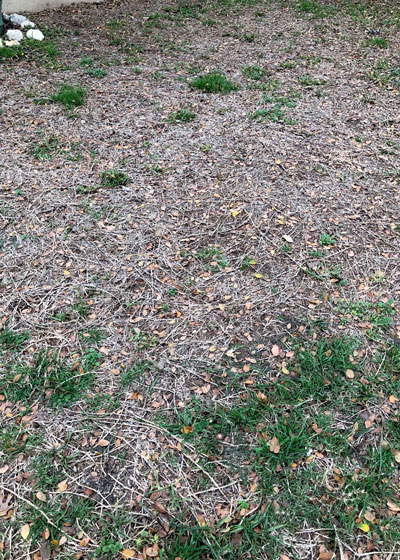
Answer: I hear so many questions from people who have struggled getting St. Augustine to grow in their yards (hundreds per year) that I learned 40 years ago always to check first on the amount of sunlight the area receives. St. Augustine requires 6 hours of direct sunlight in summer (perhaps 5 hours as far south as you are since the grass isn’t set back as much in the winter). It’s more shade-tolerant than bermuda, but it’s not shade-proof. I can’t tell if this area receives shade or not. I also can’t tell what might have killed the St. Augustine, but if it was chinch bugs last summer, one treatment of insecticide per year would be an easy solution to that problem.
In answer to your question, however, if you intend to transplant plugs from your bermuda, all you would really need to do is kill out the existing vegetation when you’re ready and then start digging. It looks like the grade of the ground is good. If it’s uneven, however, you would want to use a rear-tine rototiller to pulverize the top 2-3 inches. Rake it smoothly and plant your plugs. Use a sharpshooter spade to dig 5-inch plugs and checkerboard them 15 inches apart. Do all of this in late April or May – once the soil has warmed.
QUESTION 2
IS THERE AN ORGANIC MULCH THAT WON’T BLOW ALL OVER?
Question: I made foundation beds around my house and finished by adding 3 to 4 inches of pine bark mulch. When the winds came, the mulch blew out of the beds onto the lawn. Unfortunately, there were lots of shreds. Is there an organic mulch that won’t blow all over? Debbie W., Weatherford.
Answer: That sounds like unusually strong wind. I’ve seen pine bark mulch float in rains, but I’ve never seen it blow. It’s also too much mulch. All you really need is 1 to 1-1/2 inch. If you apply much more than that it will soak up too much of the rain and irrigation. As for a type, you might want to try a more fibrous one such as cypress mulch or pine straw. It’s a personal thing: they’re normally not my favorites visually, but they stay in place better. I would strongly advise against using any type of rock or gravel that could get picked up by mower blades and slung across the yard. Slightly larger stones (1-in. diameter, for example) would stay in place.
QUESTION 3
WHAT TREATMENT PLAN WILL SAVE THIS RED OAK?
Question: I have a young red oak tree with damage. The bark has peeled back. There appears to be a white fungus. I see possible insect holes. Can you provide a treatment plan? Cheryl P., Fort Worth.
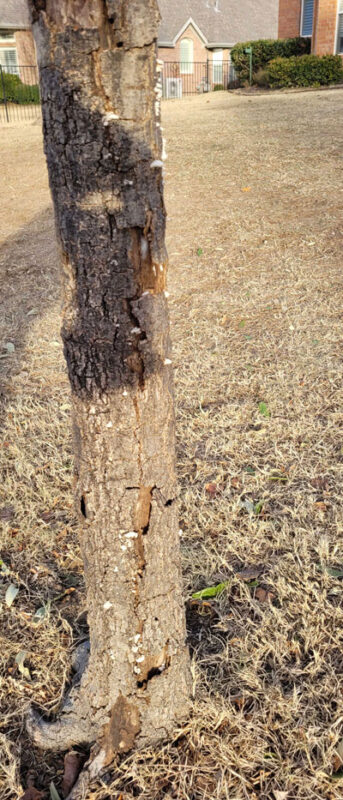
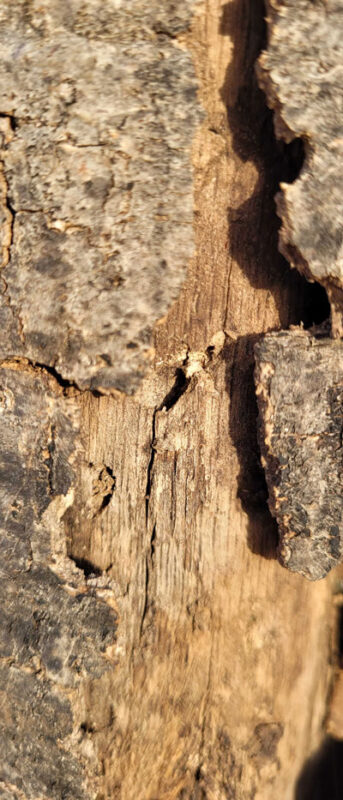
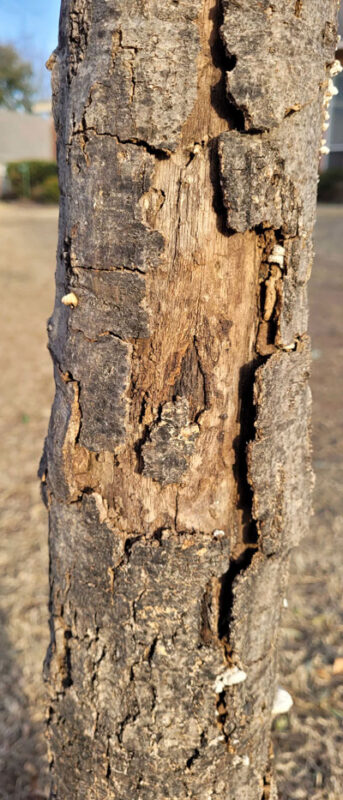
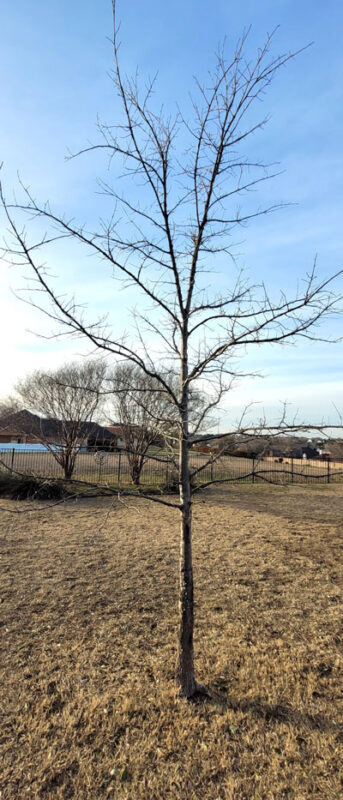
Answer: Your tree has been damaged severely by sunscald. Red oaks (and Chinese pistachios and red maples) have smooth trunks and little bark to protect them when they’re young. If their trunks are not protected by tree wrap for their first couple of years this kind of damage is sadly very common. I’m going to guess that this is the west side of the trunk where the sunlight is the hottest. The cracking shows up the third or fourth year, and then decay (such as the white fungal growth) sets in. I’d like to be encouraging, but it would take a miracle for your tree to survive this extent of damage. I’m really sorry. Whoever sold this tree to you or planted it for you should have warned you.
(Here is a story I wrote a few months ago on this topic.)
QUESTION 4
IS SCARLET’S PEAK YAUPON A GOOD REPLACEMENT FOR ITALIAN CYPRESS?
Question: Is Scarlet’s Peak yaupon holly a good replacement for Italian cypress? I’m having trouble finding nurseries that carry them. Steve R., Arlington.
Answer: If you can use a plant that is shorter, yes. Where it grows well, Italian cypress grows to 30 to 40 ft. tall. Unfortunately, cold damage and diseases kill it before it can attain that size in much of Texas. Scarlet’s Peak doesn’t get that large. I’ve never seen a mature one, but the wholesalers say it will grow to 15 to 20 ft. tall. As to sources, all I can suggest is to ask at nurseries that sell to landscape contractors. They’ll be used to sourcing unusual plants to meet their customers’ demands. Scarlet’s Peak is difficult to find. It’s slow-growing and therefore more expensive to produce. You might consider Oakland holly if you can use something shorter and a little bit wider. Avoid Sky Pencil and Will Fleming hollies. The former requires very acidic soils and the latter splays out badly and won’t hold its shape.
QUESTION 5
HOW CAN I PREVENT RABBITS COMING INTO MY YARD?
Question: How can I prevent rabbits from coming into my yard? Chia Liao, Little Elm.
Answer: If I had a product, service, or secret I could sell to get rabbits to move on down the street, I could have retired decades ago. But I’m still working, so obviously I have no clue. Nor apparently does anyone else. But you’ll find scores of suggestions, and this piece written by University of Georgia Master Gardener Susan Zaro a decade ago is the most thorough I’ve seen. It’s a great compilation but do note that the university says they make no claims that any of these will really work.
QUESTION 6
WHAT HAPPENED TO OUR NELLIE R. STEVENS HOLLY?
Question: We have three Nellie R. Stevens hollies in our side yard (south side of the house). The middle one inexplicably started dying in the fall. All three were planted at the same time (approximately 10 years ago). What happened to the one in my photo? Brian H., Allen.
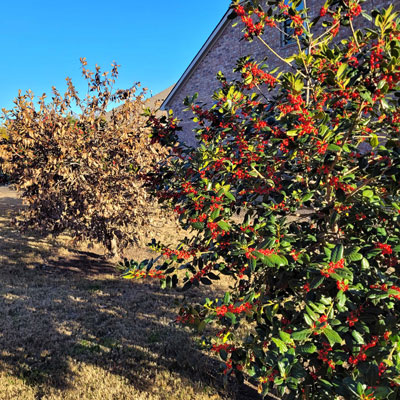
Answer: It got too dry and went past the point of no return, otherwise known as the “permanent wilting point.” It happened during the prolonged dry weather in late summer and early fall. We had the same thing happen in late summer and early fall 2022, just worse. You may have noticed the scores of hollies that died in front of the hospital along Exchange Parkway just west of Central. They all got too dry. Or, if you’ve been up toward the courthouse, the 8-year-old Nellie R. Stevens and, I believe, Mary Nell hollies along Central in McKinney toward Wilmeth. There were probably 25 of them that died. Hollies don’t give much warning. Their leaves turn a drab shade of olive green. Once you’ve seen it you recognize it for the rest of your life. It tells you there’s no turning back. A plant that looks like that is toast. It’s sad, because just one or two deep soakings during the course of recent droughts could have saved these mature specimens.
QUESTION 7
HAS THE WARM WEATHER CHANGED THE TIMING FOR APPLICATION OF PRE-EMERGENT?
Question: Has this winter’s warm weather changed the timing for our application of pre-emergent weedkiller granules this year? Todd S., Weatherford.
Answer: Not at all. I’m asked this every year when there is a brief warm spell, and I always tell folks to report back in a few weeks. By then usually there will have been another strong cold front or two. In fact, check your weather forecast for this weekend. My Weatherbug app says Weatherford is expected to go close to freezing both Sunday and Monday nights. Timing remains two weeks prior to the average date for the last killing freeze for your area. For Weatherford that’s going to put your treatment time around March 5-15. I’ve only seen that date get advanced earlier one or two times in my 54 years of living in the Metroplex.
QUESTION 8
WHAT SHRUBS OR OTHER PLANTS WOULD BE GOOD HERE?
Question: We are putting a wall next to a creek (runs only in winter). We will be adding more soil as well as an erosion blanket. What shrubs or other plants would you recommend on top of the erosion blanket? Lori T., Cedar Hill.
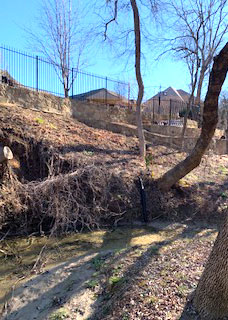
Answer: I’m uncomfortable recommending any shrubs or groundcovers yet. There is so much preparatory work to be done first. Look at how your neighbors have terraced their retaining walls. That’s what you need to do. That work needs to be done by a highly skilled landscape contractor with credentials in erosion control, and it needs to be done before it’s too late. Once all that gets stabilized and new soil is brought in to fill behind the retaining walls you can plant just about anything you want because it’s going to be level ground. But this calls for much more than just an erosion blanket. (I hope I’m understanding your question properly.)
